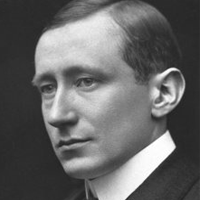Guglielmo Marconi
Marchese Guglielmo Marconi was an Italian electrical engineer and inventor who invented the wireless telegraph known today as radio.
uglielmo Marconi was born at Bologna, Italy, to an Italian country gentleman family. He was educated privately at Bologna, Florence and Leghorn. Even as a boy he took a keen interest in physical and electrical science and studied the works of Maxwell, Hertz, Righi, Lodge and others. In 1895 he began laboratory experiments at his father’s country estate at Pontecchio where he succeeded in sending wireless signals over a distance of one and a half miles.
Lacking support from the Italian Ministry, in 1896 Marconi took his apparatus to England where he was introduced to Sir William Preece, Engineer-in-Chief of the Post Office, and later that year was granted the world’s first patent for a system of wireless telegraphy. He demonstrated his system successfully in London, on Salisbury Plain and across the Bristol Channel, and in July 1897 formed The Wireless Telegraph & Signal Company Limited (in 1900 re-named Marconi’s Wireless Telegraph Company Limited). In the same year he gave a demonstration to the Italian Government at Spezia where wireless signals were sent over a distance of twelve miles. In 1899 he established wireless communication between France and England across the English Channel. He erected permanent wireless stations at The Needles, Isle of Wight, at Bournemouth and later at the Haven Hotel, Poole, Dorset.
In 1900 he took out his famous patent No. 7777 for “tuned or syntonic telegraphy” and, on an historic day in December 1901, determined to prove that wireless waves were not affected by the curvature of the Earth, he used his system for transmitting the first wireless signals across the Atlantic between Poldhu, Cornwall, and St. John’s, Newfoundland, a distance of 2100 miles.
Between 1902 and 1912 he patented several new inventions. In 1902, during a voyage in the American liner “Philadelphia”, he first demonstrated “daylight effect” relative to wireless communication and in the same year patented his magnetic detector which then became the standard wireless receiver for many years. In December 1902 he transmitted the first complete messages to Poldhu from stations at Glace Bay, Nova Scotia, and later Cape Cod, Massachusetts, these early tests culminating in 1907 in the opening of the first transatlantic commercial service between Glace Bay and Clifden, Ireland, after the first shorter-distance public service of wireless telegraphy had been established between Bari in Italy and Avidari in Montenegro. In 1905 he patented his horizontal directional aerial and in 1912 a “timed spark” system for generating continuous waves.
During his war service in Italy he continued the research on short waves, and led to the establishment of the beam system for long distance communication. In 1931 Marconi began research into the propagation characteristics of still shorter waves, resulting in the opening in 1932 of the world’s first microwave radiotelephone link between the Vatican City and the Pope’s summer residence at Castel Gandolfo. He has been the recipient of honorary doctorates of several universities and many other international honours and awards, among them the Nobel Prize for Physics, which in 1909.

Guglielmo Marconi
Date of Birth: 25 Apr 1874
Birth Place: Marescalchi Palace, Bologna, Italy
Proffession: Electrical engineer
Nationality: Italian
Death: 20 July 1937, Rome, Italy


